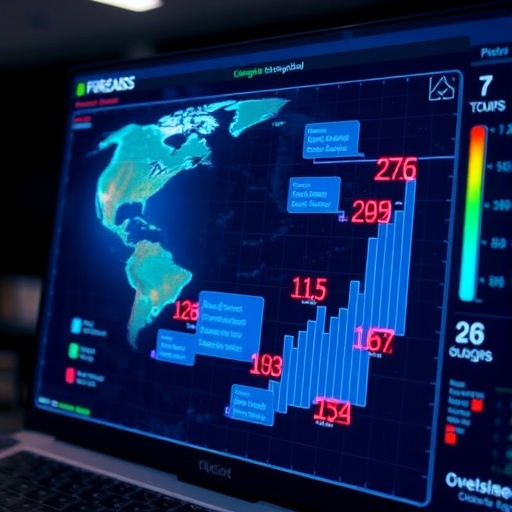Predicting the trajectory of an epidemic has long been one of epidemiology’s most daunting challenges. Healthcare systems depend on these forecasts to prepare for surges in cases that could overwhelm hospitals and strain resources. Yet, the moments when epidemic predictions matter most—the peaks—have consistently confounded traditional forecasting models. These models often falter in anticipating not only when an outbreak will reach its apex but also how severe the demand for medical care will become and the duration for which peak pressures will persist. This shortfall hampers the ability of healthcare leaders to respond dynamically, risking insufficient staffing, inadequate supply allocation, and poor patient outcomes.
Addressing this pivotal issue, researchers at the University of Texas at Austin have developed a groundbreaking approach confronting these limitations head-on. Their innovation, described comprehensively in the journal Proceedings of the National Academy of Sciences, integrates core epidemiological theory directly into data-driven forecasting models through a novel mechanism termed “epimodulation.” Unlike conventional methods that rely primarily on extrapolating recent trends to project future case counts, epimodulation equips models with an embedded understanding of epidemic progression’s underlying biological and behavioral dynamics, enabling them to anticipate the nuanced shifts that characterize the peak phase of outbreaks.
At the heart of epimodulation lies the recognition that epidemics do not unfold in linear or simplistic patterns; rather, they exhibit complex waves shaped by evolving immunity, behavioral responses among populations, and environmental influences. The model explicitly accounts for these factors, effectively instructing the forecasting algorithm to expect a deceleration in case growth as immunity accrues within the community. This insight transforms the predictive landscape, allowing models to detect early signals indicating an approaching slowdown and eventual peak—signals which often escape purely statistical or machine learning approaches that lack epidemiological grounding.
Lauren Ancel Meyers, Cooley Centennial Professor and director of epiENGAGE, emphasizes the practical impact of this advancement: “By embedding the principle that the epidemic curve will bend as population-level immunity builds, the model can more adeptly discern turning points, providing hospital administrators and public health officials with actionable insights precisely when they are most critical.” This real-time visibility into outbreak trajectory can guide pivotal decisions, including scaling staffing levels, optimizing resource distribution, and implementing targeted interventions to mitigate peak healthcare burdens.
The researchers validated the epimodulated approach across diverse historical datasets, including influenza and COVID-19 outbreaks, employing multiple forecasting frameworks. Their findings revealed a striking enhancement in accuracy—up to 55% improvement in hospital admission forecasts during epidemic peaks—without compromising performance during periods of steady case growth or decline. This increased reliability at peak times is crucial because misestimating the height or timing of surges can lead to either catastrophic under-preparedness or costly overreaction.
Importantly, epimodulation also delivered benefits when integrated into ensemble forecasting methods, which combine predictions from multiple models to produce a consensus forecast. Ensembles are widely used for their robustness, but traditionally have shared the weaknesses of constituent models around peak prediction. The incorporation of epidemiological principles through epimodulation fortified these ensembles, demonstrating the approach’s broad adaptability and potential to enhance diverse modeling platforms foundational to public health decision-making.
The theoretical underpinnings of epimodulation extend beyond any single virus or outbreak scenario. Wave-like epidemic patterns are common across infectious diseases shaped by dynamic immunity landscapes and shifting human behaviors. Diseases such as avian influenza, Ebola, and Mpox—alongside emergent pathogens yet to be discovered—commonly exhibit multi-wave transmission patterns driven by similar mechanisms. As such, this method offers a universal framework to augment prediction accuracy broadly across future epidemics, enhancing preparedness across geographies and contexts.
From a technical standpoint, the method modifies standard time series forecasting models—like the well-established ARIMA framework—by introducing modulatory terms that mimic epidemiological processes. These terms allow the model to dynamically adjust its parameters in response to inferred changes in immunity and transmission potential, effectively bending forecast trajectories toward epidemiologically plausible peaks. This hybridization of mechanistic insight with statistical rigor represents a new frontier in epidemic forecasting, transcending prior limitations of purely data-driven or purely theory-based approaches.
The timing of this advancement is particularly critical given the increasing frequency of emerging infectious diseases propelled by global travel, urbanization, and environmental change. Refining epidemic forecasts underpins effective deployment of limited resources and timely public health responses, from vaccination campaigns to hospital surge capacity planning. Epimodulation equips practitioners with sharper predictive lenses, enabling them to anticipate and adapt to evolving threats with greater confidence and speed.
Supporting this pioneering research, funding was provided by the U.S. Centers for Disease Control and Prevention, the Council for State and Territorial Epidemiologists, and unexpectedly, Tito’s Handmade Vodka. This diverse support underscores the interdisciplinary and widely recognized importance of improving outbreak forecasting capabilities. The cross-institutional collaboration features key contributors from the University of Texas at Austin, Los Alamos National Laboratory, the University of Georgia, the Santa Fe Institute, and Arizona State University, highlighting the collective expertise fueling this innovation.
In a world increasingly reliant on predictive analytics for public health strategy, epimodulation heralds a paradigm shift by embedding epidemiological intelligence within forecasting frameworks. Its demonstrated ability to substantially improve peak forecasts promises to empower healthcare systems worldwide to respond nimbly and effectively to epidemic surges, ultimately saving lives and safeguarding communities. As epidemic dynamics continue to challenge traditional assumptions, such integrative approaches provide a path forward, marrying data science with deep domain knowledge for a healthier future.
Subject of Research: Not applicable
Article Title: Improving outbreak forecasts through model augmentation
News Publication Date: 24-Oct-2025
Web References: http://dx.doi.org/10.1073/pnas.2508575122
Image Credits: University of Texas at Austin
Keywords: Disease outbreaks, Epidemiology, Infectious diseases, Modeling, Epidemics, Public health
Tags: addressing forecasting limitationsbehavioral dynamics in outbreak forecastingbiological dynamics of epidemicsdata-driven epidemic modelsenhancing patient outcomes during outbreaksepidemic prediction accuracyepimodulation in epidemiologyhealthcare resource allocationhospital surge preparednessinnovative healthcare forecasting toolsoutbreak trajectory predictionUniversity of Texas healthcare research





